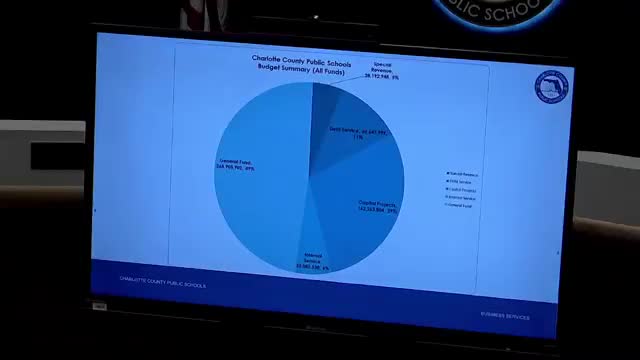District Budget Overview Shows 49% General Fund with Strong Local Revenue Sources
August 01, 2025 | Charlotte County Public Schools, School Districts, Florida
This article was created by AI summarizing key points discussed. AI makes mistakes, so for full details and context, please refer to the video of the full meeting. Please report any errors so we can fix them. Report an error »

Charlotte County Public Schools is navigating a complex financial landscape as it prepares for the upcoming school year, with a significant focus on budget management and recovery from recent hurricane damage. During a workshop held on July 31, 2025, school board members discussed the intricacies of the district's budget, which totals approximately $550 million, with nearly half allocated to the general fund.
Key discussions highlighted the importance of the special revenue fund, primarily driven by Title I and food service programs, which must maintain a self-sufficient fund balance. The board also addressed the capital projects fund, which is crucial for maintaining school facilities and addressing hurricane-related repairs. Notably, the district has been proactive in managing repairs, having already allocated $17 million for urgent roof replacements without waiting for FEMA reimbursements, a strategy that contrasts with delays seen in other local government projects.
The board's financial strategy has benefited from a robust emergency fund established by previous leadership, allowing for immediate action in the wake of Hurricane Ian. This foresight has enabled the district to expedite repairs and minimize disruption for students. The ongoing process of securing FEMA funds was also discussed, with officials noting they are currently on step four of a lengthy reimbursement process.
In terms of revenue, the district relies heavily on local funding, which constitutes about 90% of its general fund. This strong local tax base supports the district's financial health, allowing it to manage expenses effectively, including rising property casualty insurance costs.
As the school year approaches, the board's financial discussions underscore a commitment to maintaining educational facilities and ensuring a smooth transition for students, all while navigating the challenges posed by recent natural disasters. The proactive measures taken by the district are expected to yield positive outcomes as they continue to address both immediate needs and long-term financial stability.
Key discussions highlighted the importance of the special revenue fund, primarily driven by Title I and food service programs, which must maintain a self-sufficient fund balance. The board also addressed the capital projects fund, which is crucial for maintaining school facilities and addressing hurricane-related repairs. Notably, the district has been proactive in managing repairs, having already allocated $17 million for urgent roof replacements without waiting for FEMA reimbursements, a strategy that contrasts with delays seen in other local government projects.
The board's financial strategy has benefited from a robust emergency fund established by previous leadership, allowing for immediate action in the wake of Hurricane Ian. This foresight has enabled the district to expedite repairs and minimize disruption for students. The ongoing process of securing FEMA funds was also discussed, with officials noting they are currently on step four of a lengthy reimbursement process.
In terms of revenue, the district relies heavily on local funding, which constitutes about 90% of its general fund. This strong local tax base supports the district's financial health, allowing it to manage expenses effectively, including rising property casualty insurance costs.
As the school year approaches, the board's financial discussions underscore a commitment to maintaining educational facilities and ensuring a smooth transition for students, all while navigating the challenges posed by recent natural disasters. The proactive measures taken by the district are expected to yield positive outcomes as they continue to address both immediate needs and long-term financial stability.
View full meeting
This article is based on a recent meeting—watch the full video and explore the complete transcript for deeper insights into the discussion.
View full meeting